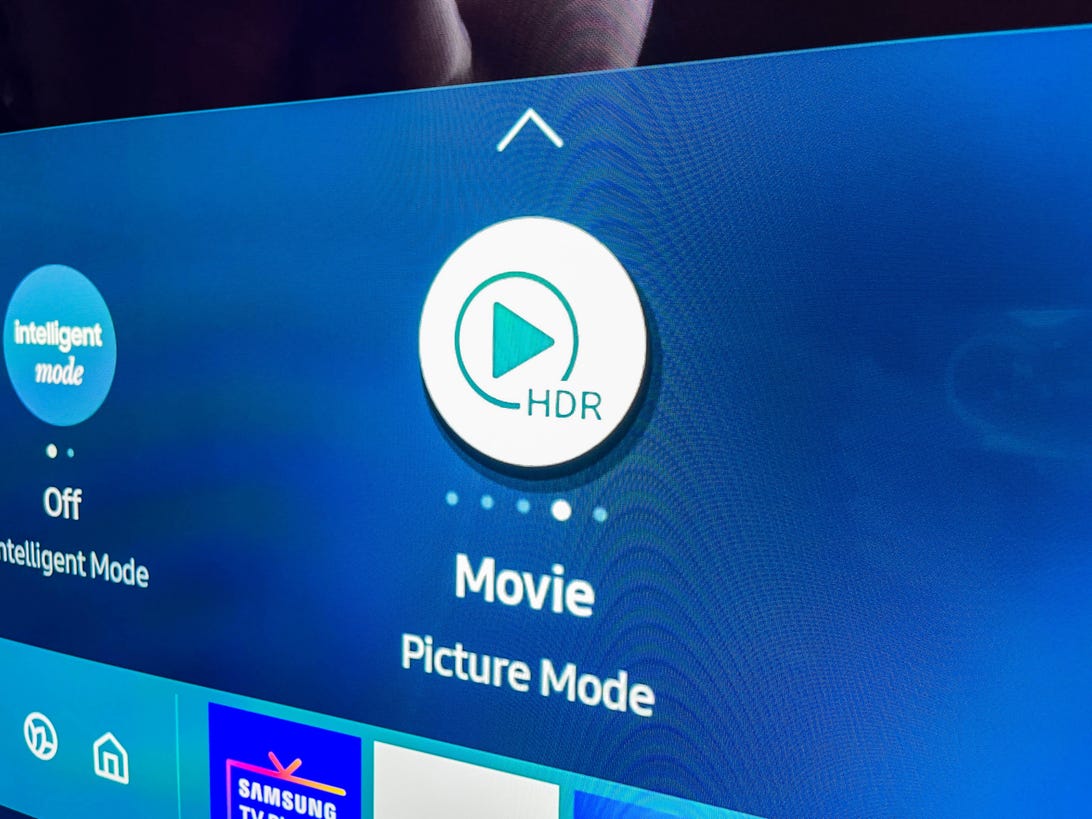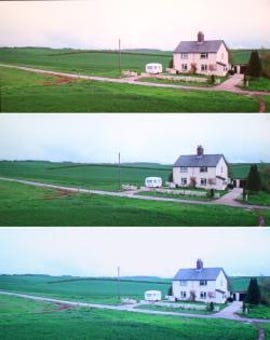Do New Tv's Show Makeup Of Old Black & White Films Tv's Show Makeup Of Old Black & White Films
What's happening
Picture settings on your new Television set might not be ideal right out of the box.
Why it matters
Getting the all-time image possible out of your Telly will brand all your shows and movies pop.
What's adjacent
We interruption down all the settings yous'll need to adjust to get the best movie quality.
You might be surprised to know that many TVs don't come looking their all-time correct out of the box. That's because the default settings -- the ones that your Boob tube uses before you make any tweaks -- don't necessarily deliver peak operation. Getting the best picture quality out of your Television receiver means that yous'll probable demand to play around with your picture settings and TV modes.

That is exactly what we exercise here at CNET equally role of our Television review process. Nosotros immediately dig into the menus to adjust the moving-picture show settings to make sure the televisions we're testing have optimal picture quality.
Fortunately, yous don't take to exist an skilful to get your TV looking great. Every TV has numerous adjustments, including different picture modes and controls for brightness, backlight, sharpness, smoothing and more than, that you can change to better the TV shows, movies and video games you watch every day.
Nosotros've cleaved down all of the settings you'll need to change in lodge to get best picture out of your Tv set. Just keep in mind that picture setting names can vary from one industry to another. A setting one Idiot box company calls "brightness" could control something totally different on another set, for example. We tackle a lot of the variations beneath, but we can't account for every TV-maker, especially on older models.
First with the right picture mode
Your TV'southward motion picture fashion has the largest effect on overall picture quality. This one setting controls multiple other settings to change the overall "wait" of your TV. If you've never inverse this setting information technology'southward probably still the default mode, typically labeled Standard, Brilliant, Dynamic, Brilliant or something similar. The TV is at its to the lowest degree accurate in this manner, with typically blown-out colors and paradigm "enhancing" features that might take hold of the heart on a shelf in a store, simply at home might brand the Tv expect worse than it could.

The easiest way to get accurate color? Put your Goggle box in Movie or Picture palace mode.
Sarah Tew/CNETA identify to starting time is switching to the mode chosenPicture palace, Picture show, Calibrated or Filmmaker . These will dial dorsum some of the movie's more garish aspects. At first, the Idiot box might fifty-fifty look soft or too warm ("cherry"). We'll talk over below why that is, but for now trust that you're actually seeing more fine item, and the paradigm is more than lifelike.
Read more:What'southward the Best Picture Manner?
Let'southward move on to some specific controls.
Backlight or OLED low-cal
- Controls the light intensity of the entire brandish
- Too high and it tin can cause headaches or eye strain, waste matter energy and, in some cases, crusade premature wear on the TV
- Too low and the image is too dim and difficult to encounter
Near all TVs will take some control that adjusts the overall lite output of the TV. It's ordinarily labeled as the backlight control, or OLED calorie-free, or something similar. On newer Sony TVs this setting is labeled Brightness, and on Roku TVs at that place are 5 settings (Brightest to Darkest) in addition to a backlight control. Whatever the label, this setting is the actual effulgence, which is by and large split from the control labeled "Brightness" (see below).
You should adjust this setting based on room lighting and personal preference. Brighter rooms and daylight viewing will telephone call for a college setting, while dwelling theater or nighttime viewing frequently looks better at a lower setting. On an LCD Television, a bright backlight tin wash out the image somewhat and reduce contrast and pop, especially on models that lack full array local dimming.
The brighter the Television is, the more energy it will consume, if you're concerned about how much electricity you use. Higher brightness too makes OLED TVs somewhat more susceptible to image retention and burn-in -- although that's unlikely with typical viewing habits, even at maximum brightness.
Read more: OLED Screen Burn down-In: What Y'all Need to Know in 2022
Contrast
On the left, what the image of some friendly beachside 'roos should look like. On the right, when the contrast control is set as well high. Notice the lack of detail in the sand and how the clouds are blown out.
Geoffrey Morrison/CNET- Controls the white or bright parts of an image
- Besides high will erase detail from clouds, snowfall and other bright objects
- Likewise depression will look dim and flat
The dissimilarity control adjusts how bright the vivid parts of the image are. In that location is an upper limit, all the same. If you fix the control too loftier, it "clips" the whites, making nigh-white details totally white. This effectively erases whatsoever detail in bright objects like clouds without making the image actually brighter.
To set dissimilarity by middle, you'll need something with a lot of brilliant areas of the image. Baseball works pretty well for this -- a fly ball, pop fly, home runs, something with shots of the sky -- or skiing (depending on flavor, clearly) or something with clouds. What you're looking for is a bright epitome, but nonetheless with highlight detail. In other words, the brilliant areas of the paradigm nevertheless have particular, and aren't only awash in white.
Once y'all've found something you retrieve volition work, turn the contrast control up until you lot start losing detail. Clouds will finish being clouds, snow volition only be glare. Now turn the control back down till you see particular again. Somewhere in this range will be platonic. Since all content is a little different you might need to tweak information technology a bit as you picket other shows/movies.
Don't want to mess with all that? Just leave it at the default for the Movie or Cinema setting.
Brightness or black level
On the left, what the teahouse should look similar. On the right, when the brightness command is gear up too low. Notice how the shadows disappear completely.
Geoffrey Morrison/CNET- Controls the blackness or dark parts of an prototype
- Besides loftier volition look apartment and washed out
- Too depression will erase detail in shadows and dark areas of the epitome
On nigh TVs, the brightness control doesn't actually control the TV's "brightness." Instead, it adjusts how dark the darkest parts of the image are. Similar with contrast, there's a fine line between too high and too low. In this case, too loftier and the epitome volition announced done out. Too low and all shadows will disappear into black. (On newer Sony TVs, this control is labeled Black Level.)

A closeup from the epitome to a higher place. Discover how you can't see anything in the shadows in the image on the correct.
Geoffrey Morrison/CNETTo fix brightness, you're looking for the opposite blazon of content from contrast. Dark movies, like Aliens or The Night Knight, are perfect for this. Somefamously dark Boob tube episodes might be too dark to utilize for this.
Turn the Brightness command down until everything disappears into blackness (or something close). From at that place, turn information technology back upwards so you can meet particular in everything, but the image doesn't look washed out. Some other test for this is a darker scene with someone with long hair. The underside of their hair (I don't know what people with hair call it) abroad from the light can be a expert place to spot shadow item -- as well dark coats at nighttime. Again, you might need to effort a few unlike shows or movies to go it right.
Sharpness
On the left, the original image of the walls of Tallinn. On the right, what it could look like if you set the sharpness control too loftier.
Geoffrey Morrison/CNET- Controls artificial edge enhancement, not image sharpness
- Likewise high erases image detail, adds a halo to fine lines
- Depending on the TV, set to 0 there'southward no effect, or a slight softening
Believe information technology or non, the sharpness control doesn't really amend sharpness. In a manner information technology improves credible sharpness, simply at the expense of bodily fine detail and usually with boosted noise. On nearly all TVs the sharpness control adds "edge enhancement," artificially accentuating any edges the TV finds in the image. The trouble is, doing this hides the actual detail in the image, and then the result looks more than artificial with less actual detail.

A close-up of the example above. Notation the extra noise and artificial "halo" around the spires on the right.
Geoffrey Morrison/CNETSo it may seem counterintuitive, but y'all should turn the sharpness command down, way down. Some TVs look all-time with the control at 0. Others look best inside the first x% or so of this control'due south range. If you're used to how your TV looks with the sharpness command way upwardly, as it typically is in the Dynamic or Bright modes, it might announced soft at first when yous turn it down. Find some high-quality 4K content and y'all might be surprised how detailed it at present looks. Yous should be able to find the sweet spot on your TV looking closely for textures in wear, wrinkles in faces, hair and beards, that kind of thing.
Read more than:Why You Need to Turn Downwardly Your Boob tube's Sharpness Control
Color and tint
- Controls color saturation and red-green shift
- A holdover from the analog Idiot box days
- Generally will be correct, or close plenty, out of the box
Mostly, the colour and tint controls will exist reasonably close to correct out of the box, especially in Cinema or Movie mode. You tin experiment with their furnishings, but it's rare they're off by more than one or two steps in either direction.

At the top, the color temperature is fix too low, or warm. At the bottom, it's set besides high, or cool.
Geoffrey Morrison/CNETColor temperature or white balance
- Controls how warm or cool the epitome looks
- Too high and the image will be as well blue
- Also low and the prototype will be too red
Color temperature is a difficult one. Your brain gets used to the color temp of your Television, so if yous modify it, information technology'south going to seem "incorrect." In fact, this is probably the start thing you'll notice if you switch to the Picture palace or Movie way. It's going to look too warm or "reddish." On most TVs, this is actually the most accurate and lifelike. Your Telly has been lying to y'all for years!
Switch to your TV'south warm color temperature mode and watch information technology for a few days. If it still seems off to you, attempt the standard mode. I promise the cool manner will expect far as well bluish once you get used to warm.
Check out my commodity on colour temp and why it matters for more info.
Motion interpolation or smoothing (the soap opera effect)

- Controls how "smooth" motility is by artificially creating new frames of video
- Besides loftier, or even enabled at all, it tin exist annoying to some
- Too low and the TV might announced soft with motion, such every bit sports
As Idiot box settings go, motility interpolation is a rather controversial topic. Many people, including film purists and pretty much everyone who works in Hollywood, hate it. Information technology makes movies look like a cheap soap opera or a video you'd shoot on your telephone. If yous've always looked at a new TV and just felt something was off, or the image just didn't wait real, information technology's probably this. Some people like it, but a lot of people don't. Your new TV nearly certainly has this feature turned on in non-Cinema or Picture show modes. Turning it off might change how y'all feel about your purchase.
Read more: Tom Cruise Wants You to Turn Off Soap Opera Effect. Here's How
Game manner
- Reduces input lag, or how long it takes for your input to register onscreen
- Commonly disables features that might make the image better
- Useful for any game that requires timing or aiming, especially online multiplayer
Input lag is how long it takes for you to press a button on a game controller so to have an onscreen event in the game. For many people this delay, measured in milliseconds, isn't noticeable. For others, especially with certain types of games, information technology tin make a massive difference. From jumping puzzles to pixel-perfect aim in a first-person shooter, getting the timing right in many games is crucial.
Minimizing input lag, normally via a feature called game mode, can make a significant difference. If you've bought a new TV and of a sudden your scores and rankings have dropped, this might be why. It's not something you desire to get out enabled all the time, since it unremarkably disables processing features that can improve the TV's picture quality.
Some TVs and consoles now support switching to this way automatically.
Farther steps
As mentioned above, the next pace to fine-tuning your TV to perfection is getting a setup disc. The Spears & Munsil disc is a great option because it gets you right to the patterns without whatsoever inapplicable fluff. If you lot simply want someone else to practice it, ideally with specialized test equipment, see if there are any Tv set calibrators in your area.
Lastly, make sure whatsoever sources you lot have, like a streaming stick or a cable or satellite box, are set to your Television's resolution (4K for 4K TVs, etc). More often than not speaking they should exercise this automatically, but it's worth digging into the settings to be sure. Your 4K TV won't look its best without 4K content. You might need to pay for a higher tier to go that, depending on the service.
Lastly, HDMI. Chances are whatsoever HDMI cables you take are fine. If yous effort to send 4K from a media streamer and information technology doesn't work, it'southward possible your HDMI cables tin can't handle the boosted resolution. Merely new HDMI cables are cheap. If your Television receiver is getting the resolution you want from your sources, new HDMI cables won't make the image wait or sound better, so you lot can save your money.
For more, cheque out CNET'due south lists of the best 55-inch, 65-inch and 75-inch TVs you can buy. Y'all can also accept a look at the best 4K TVs available.
Besides equally roofing TV and other display tech, Geoff does photo tours of cool museums and locations effectually the world, includingnuclear submarines,massive aircraft carriers,medieval castles,airplane graveyards and more.
Yous can follow his exploits on Instagram and YouTube, and on his travel web log, BaldNomad. He besides wrote a bestselling sci-fi novel about city-size submarines, along with a sequel.
Source: https://www.cnet.com/tech/home-entertainment/is-your-tv-ready-for-the-oscars-change-these-settings-for-the-optimal-picture/
Posted by: johnsonyousterromme.blogspot.com

0 Response to "Do New Tv's Show Makeup Of Old Black & White Films Tv's Show Makeup Of Old Black & White Films"
Post a Comment